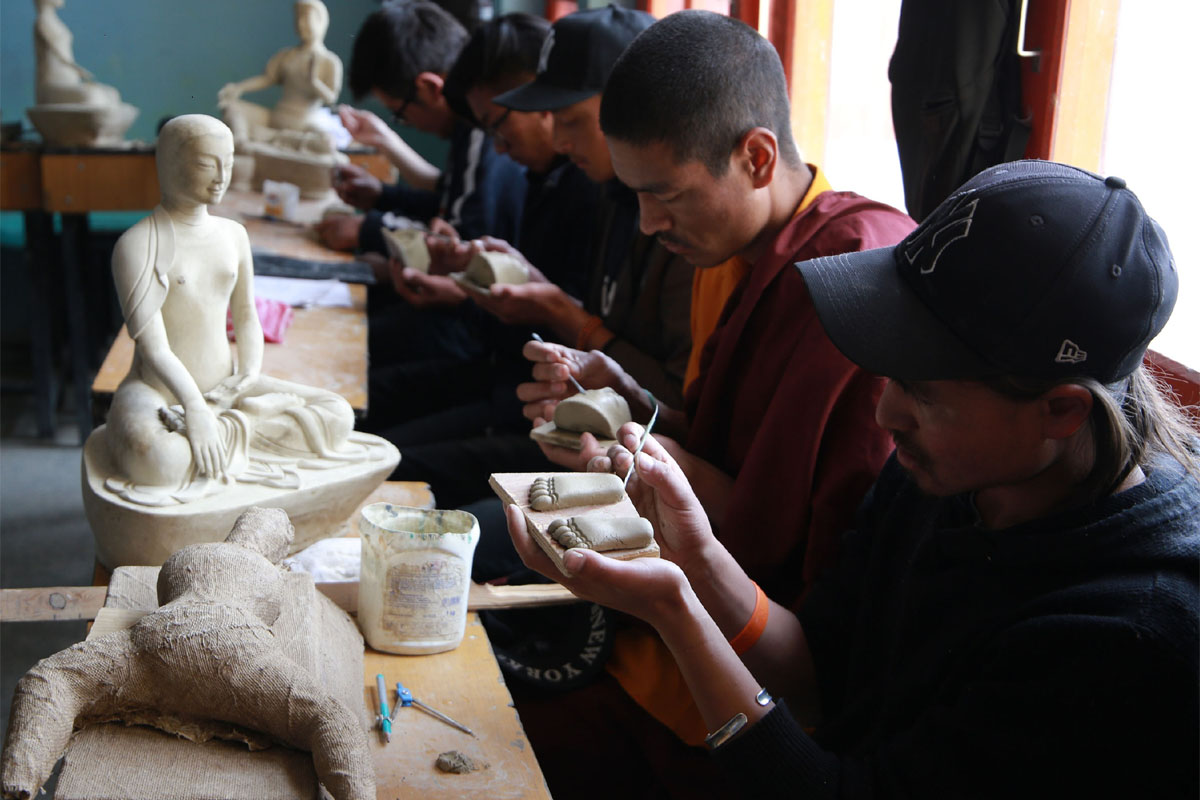Ahead of LS polls, 70343 licensed firearms deposited in Himachal Pradesh
Revealing this, a spokesperson of the Himachal Pradesh Election Department here on Tuesday, said: “Besides, these 3278 weapons have been impounded or cancelled.”
The institute is already running a five-year collaborative research programme on “community mental health and climate change” with the University of Rochester, USA.

Students taking sculpture class in the CIBS. (SNS)
Focusing on the traditional “Sowa Rigpa” medicine system of the Buddhists and preserving art and culture of the region, the Ladakh based Central Institute of Buddhist Studies (CIBS) during its ongoing diamond jubilee celebrations has decided to widen its reach nationally and internationally through different programmes.
The institute is already running a five-year collaborative research programme on “community mental health and climate change” with the University of Rochester, USA. A memorandum has been signed with School of Arts and Sciences, National University of Mongolia to develop academic exchange programmes.
A Memorandum has also been signed with IGNCA, New Delhi for developing an art conservation and documentation centre at CIBS. “Discussions are going on with several universities and organizations for collaboration and academic exchange programme for students and resource persons”, said Dr Sonam Wangchok, spokesman of the CIBS, who is also the founder of the Himalayan Cultural Heritage Foundation (HCHF) and President of the International Association for Ladakh Studies (IALS).
Advertisement
The CIBS will introduce certificate and diploma courses in Buddhism and Tibetan Language and Literature from this year.
Having been set up in Ladakh in 1959, the CIBS has done appreciable work during the past 61 years in preserving and restoring the rich cultural heritage of Buddhists. Prior to this, scholars, novices and monks of Ladakh used to go to Tibet in pursuit of higher monastic Buddhist education and used to study and do research for years in the famous Mahaviharas of Sakya, Drepung, Sera, Gadan, Tashi Lhunpo, Sagnag Chosling, Derge, Dregung etc.
This practice abruptly came to an end because of historical reasons. Hence, it was held imperative that a Buddhist institute shall be established for formal Buddhist education in India. Leh was chosen the centre for the dissemination of the Buddhist Culture and Philosophy in view of its geophysical suitability and traditional atmosphere. In 1962, at the behest of Ven Kushok Bakula, Pandit Jawahar Lal Nehru, the first Prime Minister of India, was convinced of the necessity of such an institution for the Buddhists living in the Himalayas. Thus the institution was given full accreditation in the matter of financial support under the administrative charge of the Ministry of Culture.
The Ministry of Human Resource Development on the recommendation of the University Grants Commission conferred the status of ‘Deemed to be University’ in 2016. The institute undertakes undergraduate, post-graduate and doctoral programmes in Buddhist philosophical and cultural studies, and also establishes and maintains 50 feeder schools in monasteries and nunneries in Ladakh, J&K and Himachal Pradesh.
Wangchok said that the Sowa Rigpa is a centuries-old tradition in Ladakh to provide herbal medicines to patients. The people still believe that the Sowa Rigpa system of medicines is the most useful one and has no side effect. The Government of India has recognized Sowa Rigpa as one of the traditional and useful medicine systems.
CIBS runs courses on traditional scroll and fresco paintings, traditional sculptures and traditional wood carvings and Sowa Rigpa (Baudh Medical Science). The art of Thangka painting and wall painting are very popular in the region. Monasteries of Ladakh are the storehouse of numerous Thankha paintings and frescoes. Several hundred years old wall paintings are still preserved in the monasteries including the famous Alchi Choskhor in Leh district.
Besides, CIBS runs several other projects including compilation of encyclopedia of Himalayan Buddhist Culture, manuscripts resource centre and conservation centre, translation and publication units and library. A number of students are receiving 6 years course from this institute with the aim of keeping alive the centuries-old tradition of Thangka and wall paintings.
The National Mission for Manuscripts has designated CIBS as the Manuscripts Resource Centre and Manuscripts Conservation Centre for the Ladakh region. The institute so far has documented about 37,722 manuscripts from 2389 different monasteries, palaces and individuals of Ladakh region. The institute is planning to document all available manuscripts in the region. Besides, 2515 folios from manuscripts have been restored and conserved.
Advertisement